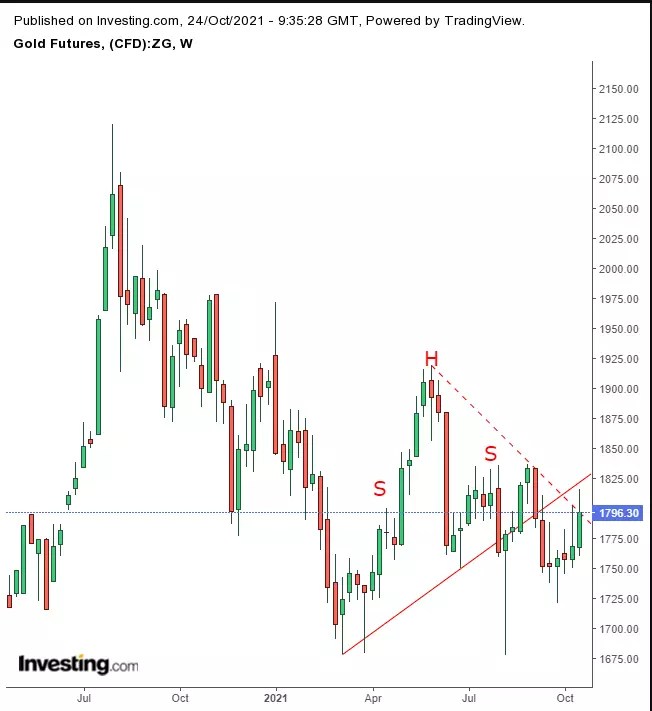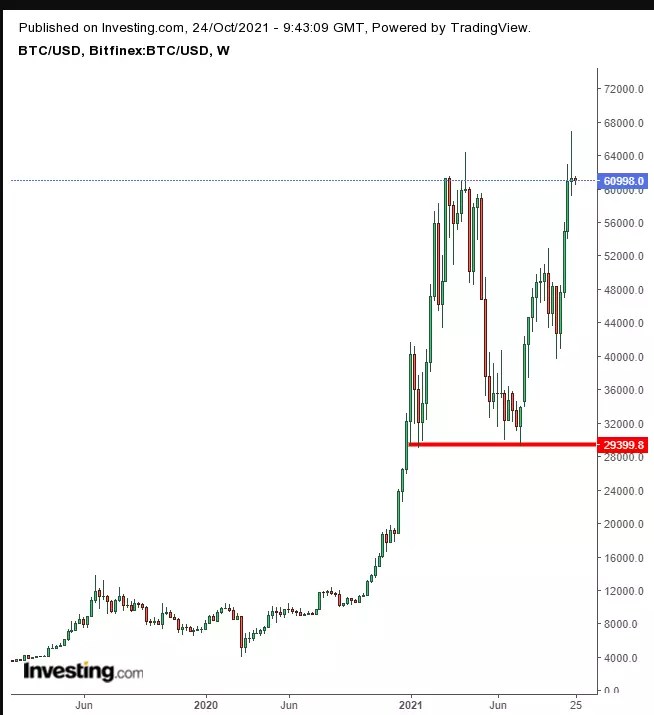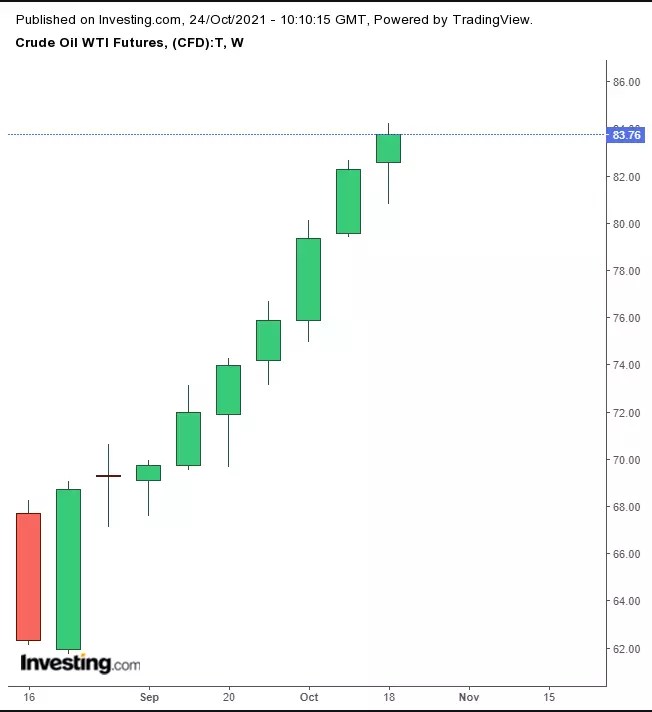Companies representing almost half of the S&P 500 report earnings this coming week
Investors await critical outlook forecasts
Oil hovers near 2014 levels
Notwithstanding beats by nearly 84% of companies that have already reported during this earnings season, investors remain anxious ahead of the torrent of releases scheduled for the coming week, which will feature some of the biggest technology companies in the US.
These mega caps, including Apple (NASDAQ:AAPL), Microsoft (NASDAQ:MSFT), Amazon (NASDAQ:AMZN), Facebook (NASDAQ:FB) and Alphabet (NASDAQ:GOOGL)—all stalwarts of the marquee tech group dubbed FAAMGs—have been the driving force behind much of the equity bull market in recent years.
Can Big Tech Expansion Continue?
Will big tech continue delivering growth, even when faced with pressure from supply chain obstacles, increased government regulations and escalating Treasury yields? The latter, in particular, is a headwind for growth stocks.
Yields tend to rise when investors are confident about the prospects for economic expansion, which naturally favors value stocks sensitive to the economic cycle. That, at least, is conventional wisdom.
But conventional wisdom isn’t always correct. Fisher Investments, an independent money management firm based in Camas, Washington, notes that tech shares can do well—or poorly—in a variety of interest rate environments. Indeed, based on their calculations, over the past 20 years, there has been a -0.10 correlation between rates and the sector’s performance. Fisher’s numbers indicate the technology sector moved in tandem with Treasury yields only 10% of the time.
Nevertheless, even if that’s accurate, the market narrative consistently insists the correlation between tech stocks and yields is much stronger. Therefore, investors bombarded by the general consensus view are likely to believe it, selling tech shares as yields rise whether that’s historically accurate or not, creating a self-fulfilling prophecy.
With that said, traders will have to rapidly take a stand this coming week, as the biggest tech names, AAPL, MSFT, GOOGL, AMZN and FB, release their quarterly numbers. These five companies alone make up more than 22% of the S&P 500 by weighting, which means this quintet of stocks has an outsized influence on the broader benchmark.
Goldman Sachs reported that these firms also account for 46% of the SPX’s market value. We imagine investors are now weighing whether the S&P 500 has the ability to resume its record-breaking rally into November.
So far in October, the gauge has gained 5.5%. However, it shed 4.8% of value during September, its sharpest monthly drop since the March 2020 bottom, when the worst global health crisis in 100 years pummeled markets worldwide.
One thing we expect investors to focus on will be guidance from these tech behemoths. Companies like Netflix (NASDAQ:NFLX), which beat on earnings but balked on forecasts, providing warnings instead citing inflation as the reason, were mercilessly sold off. Additionally, the global chip shortage remains an ongoing, significant worry for both the companies and their investors. Expect to hear more about that during guidance from each of these companies in the coming week.
Inflation Worries Linger
On Friday, US stocks sold off after Fed Chair Jerome Powell indicated further concern about inflation, and said the US central bank should begin cutting back on asset purchases, though he didn’t advocate raising rates just yet. Powell said the Federal Reserve was following price pressures closely and would administer policy accordingly.
The tech-heavy NASDAQ 100 fell 0.9%, underperforming among major US indices. Conversely, the mega cap Dow Jones, which lists blue-chip value stocks, was the only benchmark in the green, +0.2%, as the trading week came to a close.
That’s a clear example of value outperforming growth due to rising inflation. It mimics the idea that increasing Treasury yields would provide the same paradigm.
Treasury yields, including for the 10-year note, slumped on Friday, for the first time in eight days.
The dollar slipped for the second week but seemed to find support as the week came to a close.
 Dollar Weekly
Dollar Weekly
From a technical perspective, this is a return move, testing the neckline of a massive double-bottom and, therefore, a buying dip for aggressive traders. More cautious individuals would wait for confirmation of support.
Gold rose for the second week straight.
 Gold Weekly TTM
Gold Weekly TTM
The price found resistance by the uptrend (dotted) line since the May high, as well as the possible neckline of a H&S continuation pattern.
Bitcoin failed to maintain it’s all-time high levels of last week but continues to trade above $60K.
 BTC/USD Weekly
BTC/USD Weekly
The digital token developed a weekly high-wave candle, which may be a warning of considerable volatility ahead. This single candle could be especially problematic, given it developed at the same level as the previous peak, setting up a potentially enormous double-top.
Crude oil closed near the top of its session on Friday as well as near its highest level since 2014. That accomplishment occurred during Wednesday’s trading.
 Oil Weekly
Oil Weekly
Although the price of WTI moved sideways all last week on the daily chart, on the weekly chart, the commodity notched its 9th straight weekly gain, its longest up-streak on record.
Week Ahead
All times listed are EDT
Monday
4:00: Germany – Ifo Business Climate Index: expected to decline to 97.9 from 98.8.
Tuesday
10:00: US – CB Consumer Confidence: seen to dip to 108.8 from 109.3.
10:00: US – New Home Sales: likely to rise to 755K from 740K.
20:30: Australia – CPI: forecast to remain steady at 0.8% QoQ.
Wednesday
8:30: US – Core Durable Goods Orders: anticipated to edge up to 0.4% from 0.3%.
10:00: Canada – BoC Interest Rate Decision: predicted to remain unchanged at 0.25%.
10:30: US – Crude Oil Inventories: to surge to 1.857M from -0.431M.
11:00: Canada – BoC Press Conference
23:00: Japan – BoJ Interest Rate Decision: predicted to remain on hold at -0.10%.
Thursday
3:55: Germany – Unemployment Change: to jump to -20K from -30K.
7:45: Eurozone – Deposit Facility Rate: forecast to remain at -0.50%.
7:45: Eurozone – ECB Interest Rate Decision
8:30: US – GDP: expected to plunge to 2.8% from 6.7%.
8:30: US – Initial Jobless Claims: anticipated to edge up to 292K from 290K.
10:00: US – Pending Home Sales: to drop to 0.5% from 8.1%.
20:30: Australia – Retail Sales: forecast to come in at 0.2% MoM.
Friday
4:00: Germany – GDP: predicted to rise to 2.2% from 1.6% QoQ.
5:00: Eurozone – CPI: likely to edge higher to 3.7% from 3.4%.
8:30: Canada – GDP: seen to surge to 0.7% from -0.1% MoM.
Saturday
21:00: China – Manufacturing PMI: expected to rise to 50.1 from 49.6, re-entering growth territory.
Source: Investing.com



























